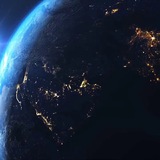Time magazine has published the best photos of the James Webb telescope of the year
This media is not supported in your browser
VIEW IN TELEGRAM
A view of the night side of the Earth from the ISS
This media is not supported in your browser
VIEW IN TELEGRAM
This is what the transit of Mercury on 9 May 2016, seen by the AIA telescope at the Solar Dynamics Observatory, looks like.
This media is not supported in your browser
VIEW IN TELEGRAM
Tidal destruction💥
The rings of gas giants are thought to be formed from the material of former satellites that came too close to the body of the giant and were destroyed by its tidal forces.
There is a certain orbital height (the Roche limit) below which the side of the satellite facing the planet experiences an outward gravitational force greater than the gravitational force at the centre of the satellite. As a result, the moon crumbles🪨
As it collapses, the particles of the former satellite are distributed along its orbit. After some time, the remains of the satellite form a ring
The rings of gas giants are thought to be formed from the material of former satellites that came too close to the body of the giant and were destroyed by its tidal forces.
There is a certain orbital height (the Roche limit) below which the side of the satellite facing the planet experiences an outward gravitational force greater than the gravitational force at the centre of the satellite. As a result, the moon crumbles🪨
As it collapses, the particles of the former satellite are distributed along its orbit. After some time, the remains of the satellite form a ring
This media is not supported in your browser
VIEW IN TELEGRAM
On 14 December 1972, three NASA astronauts Eugene Cernan, Harrison Schmitt, and Ronald Ellwyn lifted off from the surface of the satellite, ending the last lunar mission, Apollo 17 of the Apollo Expedition.
No one else has flown to the moon since.
No one else has flown to the moon since.
This media is not supported in your browser
VIEW IN TELEGRAM
Space jellyfish phenomenon is a phenomenon that can be observed during a rocket launch 🚀
It is caused by the reflection of sunlight from the high-altitude gas plumes of a rocket during morning or evening twilight, when the observer is in darkness and the exhaust plumes are at high altitudes in direct sunlight. This glowing phenomenon resembles a jellyfish.
It is caused by the reflection of sunlight from the high-altitude gas plumes of a rocket during morning or evening twilight, when the observer is in darkness and the exhaust plumes are at high altitudes in direct sunlight. This glowing phenomenon resembles a jellyfish.
This media is not supported in your browser
VIEW IN TELEGRAM
Radiation storm has started on Earth - a strong geomagnetic storm 7-8 points out of 9 is possible
The storm is moderate, but experts do not exclude the possibility of a strong increase in its level.
The storm causes interference with radio communications on different frequencies across the planet, interference with navigation and deterioration of the well-being of weather-dependent people.
The storm is moderate, but experts do not exclude the possibility of a strong increase in its level.
The storm causes interference with radio communications on different frequencies across the planet, interference with navigation and deterioration of the well-being of weather-dependent people.
Media is too big
VIEW IN TELEGRAM
Docking of the Soyuz spacecraft with the International Space Station 🛰
This media is not supported in your browser
VIEW IN TELEGRAM
On 5 February 1971, the lunar module Antares, of the Apollo 14 spacecraft, crewed by Alan Shepard and Edgar Mitchell, successfully landed on the surface of the Moon near the Fra Mauro Highlands 🌑
This media is not supported in your browser
VIEW IN TELEGRAM
How a solar eclipse looks from space
The shadow consists of two concentric cones called the shadow and penumbra 🌓
The shadow consists of two concentric cones called the shadow and penumbra 🌓
